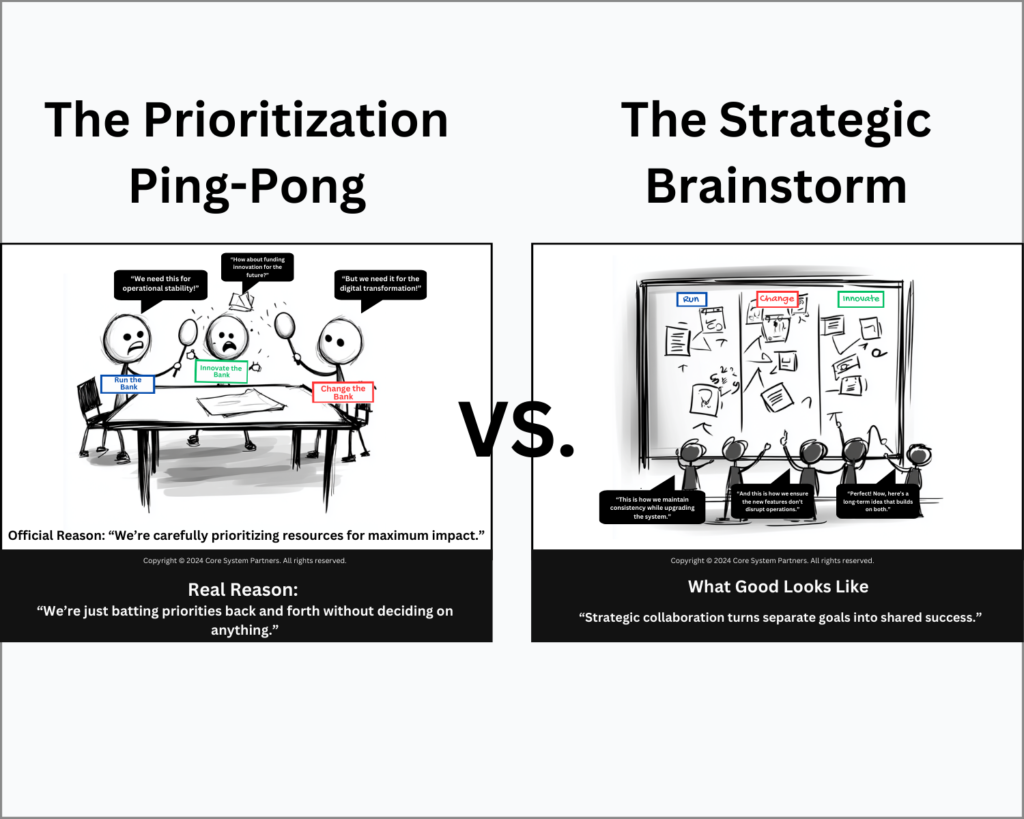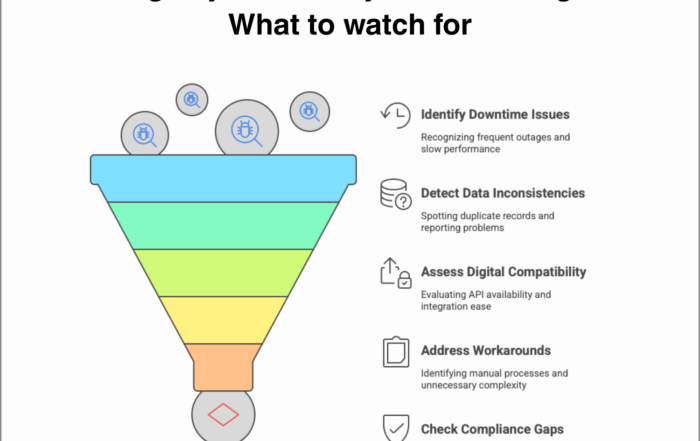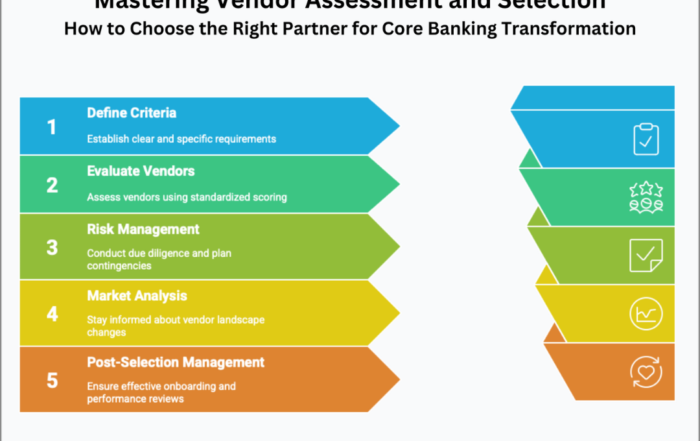Vol 3 #8

From Silos to Synergy: How strategic brainstorming transforms core banking by aligning operations, change, and innovation teams towards shared goals and cohesive progress.
In core banking, managing priorities can feel like a never-ending game of ping-pong. The Run, Change, and Innovate teams sit around a table, volleying their priorities back and forth. Operations needs stability, Transformation demands change, and Innovation pushes for future investment. This tug-of-war over resources and attention is humorously captured in our cartoon “The Prioritization Ping-Pong”, where each team clings tightly to its agenda, seemingly trapped in a cycle of indecision.
But imagine a different scene—one where these same teams gather around a whiteboard, contributing to a shared vision, as illustrated in “The Strategic Brainstorm”. Instead of batting priorities around, each team builds on each other’s ideas, fostering a sense of collective ownership and strategic alignment. The result? A powerful, actionable plan that balances daily operations with adaptive processes and forward-looking innovation. Let’s explore how banks can shift from prioritization ping-pong to a strategic brainstorm that truly advances transformation.
The Reality of Prioritization Ping-Pong
In “The Prioritization Ping-Pong”, each team sits at the table with its own pressing needs. The Run team emphasizes the importance of maintaining stability, Change pushes for digital transformation, and Innovate urges investment in the future. Each team is right, yet they’re often at odds with each other, leading to a stalemate. Sound familiar?
Why Does Prioritization Ping-Pong Happen?
- Competing Goals: Each department has a distinct mission, making it challenging to prioritize one over another without leaving a function feeling sidelined.
- Limited Resources: When budgets and resources are tight, every team feels the need to advocate for their share, creating a tug-of-war over funding.
- Lack of Structured Collaboration: Without a coordinated process, discussions can quickly become a series of back-and-forth arguments instead of constructive dialogue.
I’ve been in those meetings where the focus shifts from finding solutions to defending territories. It’s exhausting and, ultimately, unproductive. When each team is focused solely on its own priorities, the broader mission of the bank gets lost in the shuffle, leading to delays and missed opportunities.
Enter the Strategic Brainstorm: Building a Collaborative Vision
In contrast, “The Strategic Brainstorm” offers a glimpse into a more constructive approach. Here, the Run, Change, and Innovate teams come together around a shared whiteboard, each contributing to the bank’s vision. Instead of competing, they’re collaborating, aligning their goals to achieve a balanced approach. This shift from defending individual agendas to building a collective strategy is the foundation of effective transformation.
How Strategic Brainstorming Transforms Collaboration
The strategic brainstorm model turns the traditional priority-setting process on its head, fostering an environment where every perspective is valued. Here’s what sets it apart:
- Open Dialogue: Each team has the chance to voice its priorities and explain its needs, fostering empathy and understanding among departments.
- Collaborative Idea-Building: Instead of arguing over resources, teams are encouraged to build on each other’s ideas, creating solutions that benefit the bank as a whole.
- Unified Vision: The focus shifts from “my priorities” to “our mission,” aligning individual goals with the bank’s overarching strategy.
When I’ve seen teams come together in this way, the atmosphere changes. People aren’t defending their roles; they’re contributing to a bigger picture. It’s amazing how simply changing the format of a discussion can lead to more innovative and actionable ideas.
Moving from Ping-Pong to Strategic Collaboration: Steps for Success
Shifting from a game of prioritization ping-pong to a productive strategic brainstorm requires intentional changes in approach and mindset. Here are some practical steps to help banks make this transition.
1.Set a Clear Agenda with Shared Objectives
Before any meeting, define the overarching goals of the discussion. By framing the conversation around shared objectives, you give teams a common starting point and help them see the value in each other’s contributions.
- Example: Begin with a clear agenda item like “Improving Customer Experience,” and ask each team how their priorities contribute to this goal. This encourages a sense of alignment from the start.
2. Establish a Structured Brainstorming Process
A well-structured brainstorming session ensures that each team has time to present its ideas without interruption, followed by a collaborative discussion. Use tools like whiteboards or sticky notes to capture ideas visually, making it easier to see connections and build on each other’s contributions.
- Example: Start with a round-robin format where each team shares one idea, then open the floor for responses, allowing each team to add to or refine the idea.
3. Focus on Integrative Solutions
Encourage teams to consider how their priorities intersect with those of other departments. This integrative thinking can lead to creative solutions that support multiple goals, reducing the need for compromise.
- Example: If the Run team emphasizes stability while Change pushes for digital transformation, explore solutions like phased rollouts that maintain operational continuity while introducing new technology incrementally.
4.Use a Visual Collaboration Tool
A shared whiteboard or digital tool can help teams visualize how each idea connects to the bank’s mission. By mapping ideas visually, you create a dynamic record of the discussion that helps maintain focus and ensures everyone’s voice is captured.
- Example: Use a digital whiteboard that all teams can access remotely, adding layers to the board as ideas evolve, so no contributions get overlooked.
5. Celebrate Collaborative Wins
Acknowledge and celebrate milestones that result from collaborative brainstorming sessions. Recognizing the value of each team’s contribution fosters a culture of mutual respect and reinforces the benefits of working together.
- Example: At the end of each session, summarize the ideas and highlight the contributions of each team. Follow up with a message or a quick gathering to acknowledge the progress made.
Why Strategic Brainstorming Works
A structured brainstorming process doesn’t just lead to better ideas—it fosters a culture of teamwork, respect, and shared purpose. When teams move from volleying priorities to building on each other’s ideas, they experience tangible benefits that drive both individual and collective success.
Improved Morale
When everyone’s ideas are heard and valued, morale improves. Teams feel more engaged and motivated, knowing that their work is part of a collective effort.
Faster Decision-Making
With clear processes and shared objectives, teams spend less time debating and more time making decisions that move the bank forward.
Greater Innovation
Collaborative brainstorming encourages out-of-the-box thinking. When departments build off each other’s ideas, they’re more likely to develop innovative solutions that address multiple needs at once.
Building a Culture of Collaborative Problem-Solving
In core banking, transformation requires more than just balancing priorities—it demands that teams work together, building on each other’s strengths to achieve shared goals. The difference between “The Prioritization Ping-Pong” and “The Strategic Brainstorm” is clear. One approach keeps teams stuck in a cycle of indecision, while the other moves them toward a unified, actionable plan.
As you think about your own organization, consider this: Are we playing a game of ping-pong with our priorities, or are we engaging in a strategic brainstorm that builds on everyone’s strengths? By fostering a culture of collaborative problem-solving, we can shift from defending individual priorities to achieving collective success, creating a bank that’s not just responsive but also resilient and ready for the future.
#CoreBankingTransformation #RunChangeInnovateTheBank




